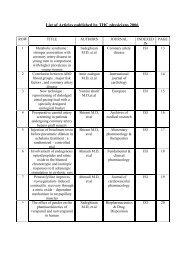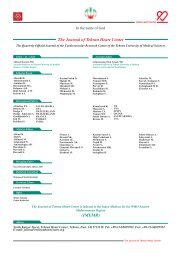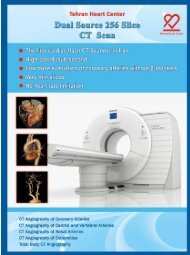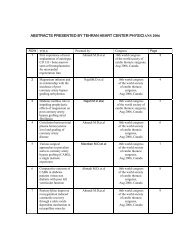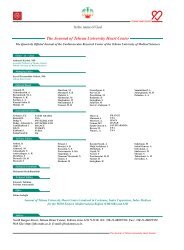THE JOURNAL OF TEHRAN UNIVERSITY HEART CENTER
THE JOURNAL OF TEHRAN UNIVERSITY HEART CENTER
THE JOURNAL OF TEHRAN UNIVERSITY HEART CENTER
You also want an ePaper? Increase the reach of your titles
YUMPU automatically turns print PDFs into web optimized ePapers that Google loves.
The Journal of Tehran University Heart Center<br />
Discussion<br />
Pathogenesis<br />
Many studies have demonstrated that the leading cause<br />
of PVT is subtherapeutic anticoagulation, which chimes<br />
in with the findings in our two cases. 6-10 This is most often<br />
due to either patient noncompliance or iatrogenic cessation<br />
of anticoagulants in preparation for another procedure.<br />
Furthermore, valve design and materials influence the<br />
incidence of thrombotic complications. Some mechanisms<br />
have a role in PVT formation such as molecular interactions<br />
and influence of transprosthetic blood flow. Molecular<br />
interaction occurs between corpuscular blood components,<br />
plasma, and artificial surfaces. The initial adsorption of<br />
plasma proteins (fibrinogen, fibronectin, von Willebrand<br />
factor, vitronectin, and thrombospondin) on the artificial<br />
surface is generally followed by platelet adhesion. The<br />
passage of blood through the prosthetic valve creates a<br />
turbulent flow with shear stress, which gives rise to a<br />
structurally and metabolically damaged endocardium and<br />
thus reduces its resistance to thrombosis. Also, subclinical<br />
hemolysis with the release of adenosine diphosphatase,<br />
platelet factor 4, beta-thromboglobulin, and other proteins<br />
triggers the activation of the plasma coagulation system.<br />
Other intrinsic factors can progress to thrombus formation;<br />
these factors include loss of active atrial contractions (atrial<br />
fibrillation), presence of some systemic diseases (e.g.<br />
systemic lupus erythematosus) or malignant tumors, and<br />
incomplete endothelization of the sewing ring. Use of some<br />
drugs such as contraceptives leads to hypercoagulability<br />
state 3, 11-14 Recently, Ricome et al. reported two cases of PVT<br />
secondary to heparin-induced thrombocytopenia. 15<br />
Type and position of the prosthetic valve and time from<br />
1, 13, 16, 17<br />
surgery can influence thrombus formation (Table 2).<br />
Additionally, some studies have indicated that season can be<br />
correlated with an increased risk for thrombotic events. 18-20<br />
Piper et al. reported that PVT during winter months occurred<br />
more frequently than in the other seasons. 13<br />
Signs and Symptoms<br />
In contrast to the acute presentation of left-sided PVT, the<br />
onset of the symptoms of tricuspid PVT is usually insidious,<br />
and its diagnosis is often delayed. Sometimes symptoms<br />
are so slight that the patient is likely to have suffered from<br />
them for months or even a year without feeling the need for<br />
referral to the hospital. 4 Sometimes, the patient even may<br />
have no symptoms related to the tricuspid vale thrombosis,<br />
and the thrombosis is detected only during routine clinical<br />
examination. 4, 6 However, the involvement of both leaflets is<br />
usually required to produce symptoms. 6 The most frequent<br />
symptoms related to tricuspid valve malfunction include<br />
4, 6,<br />
dyspnea, ascites, peripheral edema, and systemic emboli.<br />
21, 22<br />
Also, sometimes the disappearance or attenuation of the<br />
prosthetic valve noise may be reported by the patient and/<br />
or relatives. Moreover, in some cases where an interatrial<br />
communication is present, a pulmonary embolus or a leftsided<br />
embolic event may be the presenting manifestation of<br />
23, 24<br />
tricuspid PVT.<br />
It seems that physical examination may provide important<br />
clues for the diagnosis of tricuspid PVT, compared to the<br />
thrombosis of the left side, which normally has more severe<br />
symptoms. 25 Absence or muffling of prosthetic sounds<br />
in the tricuspid position might be noted. Other findings<br />
include auscultation of a new holosystolic murmur located<br />
at the left lower sternal border or in the subxiphoid region<br />
that may increase with inspiration or maneuvers that<br />
increase venous return (denoting the presence of tricuspid<br />
regurgitation), auscultation of a new murmur that is low in<br />
frequency, diastolic, located at the lower left sternal border<br />
or infraxiphoid area, and increases with inspiration and other<br />
maneuvers that increase tricuspid flow velocity (denoting<br />
tricuspid stenosis), or auscultation of a combination<br />
of murmurs that characterize both of these conditions.<br />
Sometimes mid-diastolic and/or pan-systolic murmurs can<br />
be heard in the tricuspid area (Zhang DY, Lozier J, Chang R,<br />
Sachdev V, Chen MY, Audibert JL, Horvath KA, Rosing DR.<br />
Case study and review: Treatment of tricuspid prosthetic<br />
valve thrombosis. Int J Cardiol 2011 Oct 14. [Epub ahead<br />
of print]).<br />
Diagnosis<br />
Ahmad Yaminisharif et al.<br />
The onset of the symptoms of tricuspid PVT is usually<br />
insidious and sometimes the patient has nonspecific<br />
symptoms or is even symptomless; therefore, suspicion of<br />
tricuspid PVT may be raised by physical findings, symptoms<br />
of heart failure, or rarely the diagnosis of embolization,<br />
especially in patients with poor anticoagulation therapy 8,<br />
17, 25<br />
NYHA has classified PVT in functional classes I to<br />
IV. The non-obstructive forms of PVT (NYHA functional<br />
Table 2. Thrombogenicity of mechanical prosthetic valve based on type, position, and time from surgery<br />
Lower<br />
Higher<br />
Valve type Bileaflet-tilting-disk Caged-ball single-tilting-disk<br />
Position Mitral or aortic Tricuspid<br />
Time from replacement After 3 months First 3 months<br />
150



